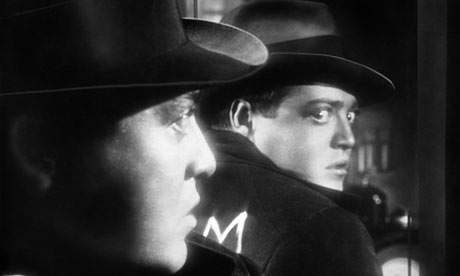 Genre: Crime/Thriller
Genre: Crime/Thriller Director: Fritz Lang
Writers: Thea von Harbou and Fritz Lang
Producer: Seymour Nebenzal
Cast: Peter Lorre, Otto Wernicke, Gustaf Gründgens, Ellen Widmann, Inge Landgut, Theodor Loos, Friedrich Gnass
Music: Edvard Grieg
Cinematography: Fritz Arno Wagner
Editing: Paul Falkenberg
Distribution: Vereinigte Star-Film GmbH
Release Date: May 11, 1931
Running Time: 110 min
Fritz Lang’s M has one of the most evocative openings of any film. Even for those who have their doubts about watching an early German sound film will be nailed to their seats. It’s almost impossible to describe in words, because the entire sequence, and the entire film for that matter is so rooted in visual storytelling that it needs to be seen to be appreciated. While Lang’s contemporaries in America were using sound for mostly comedies and musicals, Lang crafted with his first sound film a disturbing tale about a child murderer on the loose played by Peter Lorre.
In M Lang pushed the capabilities of the new sound technology to the limits, using it not to be the focus of the film, but to be another element to the film. The focus here is still on pure cinematic storytelling. The story of M, about the child murderer who finds himself hunted by both the law and the criminal underworld is simple on paper, but by using innovative storytelling techniques, Lang elevates the film above simple pulp fiction. His direction, for one, lends the film an almost documentary like realism at times. While the look and feel of the film is still heavily indebted to German Expressionism, Lang’s camera almost voyeuristically intrudes itself into the events that unspool on screen. It isn’t until about a half hour or so into the film that we have our two main characters firmly introduced, the Inspector Lohmann (Otto Wernicke), the criminal ringleader Safecracker (Gustaf Gründgens), and the murderer doesn’t even come in until near the end of the film. Instead Lang begins the film by highlighting the paranoia gripping Berlin. People erupt in mobs, the police raid the bars, neighbors turn suspicious against one another, and it’s a feeling that never lets up even for a minute.
It’s been said that M was meant to be an allegory for the rise of the Nazis, but I think the themes put forth in M remain just as, if not even more prevalent in today’s times. Lang also touches on issues such as psychosis, mob justice, and capital punishment, but he does so in a manner that I found refreshingly complex. Rather than shoving an agenda down his viewer’s throats, he allows us to come to our own conclusions about the events on-screen, and what haunting events they are. The final half hour where the criminals place the murderer on a mock trial has lost none of its power to send chills straight down the spine of any viewer. This is in part due to the central performance by Peter Lorre. He plays the murderer as a nervous, wide eyed man who is always looking over his shoulder. He manages to express so much in so little screen time and without very much dialogue by just using his face, though his delivery of his final speech to the “court” is a brilliant display of screen acting, it’s Lorre’s face that will stick with the viewer long after.
Of course, Lang infuses the film with a brilliant visual sensibility. Every composition, camera angle, movement is carefully planned out for maximum effect, and the lighting is spot on. He has such an eye for atmosphere and space, his camera capturing the seedy dives and smoke-choked rooms of the film. Lang overcomes any technical limitations there may be. One scene I particularly liked was towards the middle of the film where the criminals and the cops are debating what to do about the murderer that has made life so difficult for both groups. Lang uses similar visual compositions, and intercuts between the two groups using dialogue. Also, Lang allows the rooms to become more smoke filled as the scene progresses increasing the intensity of the moment. I also found Lang’s use of mirrors and reflective surfaces to be quite expressive, one moment that has stuck with me is when Peter Lorre stands in front of a shop window as the reflections of jewelry create a square around his head, almost as if it is entrapping him. Though Lang’s visual style is bold, he often understates the events on screen. No murders are ever shown, just a ball rolling away or a balloon floating off, making everything all the more ominous and evocative.
M is one of the essential classics of the silver screen, it’s a powerful, haunting work by one of the cinema’s great artists. I can’t recommend this film enough, and the Criterion DVD is a first class restoration (I swear, I’m not working for them or anything, I just love their stuff).











